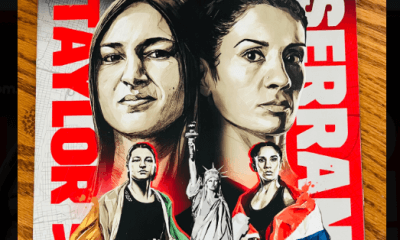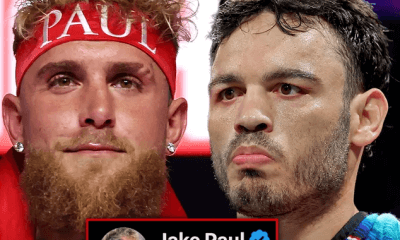Featured Articles
The Mirage Goes Dark and Another Storied Venue for Boxing Bites the Dust
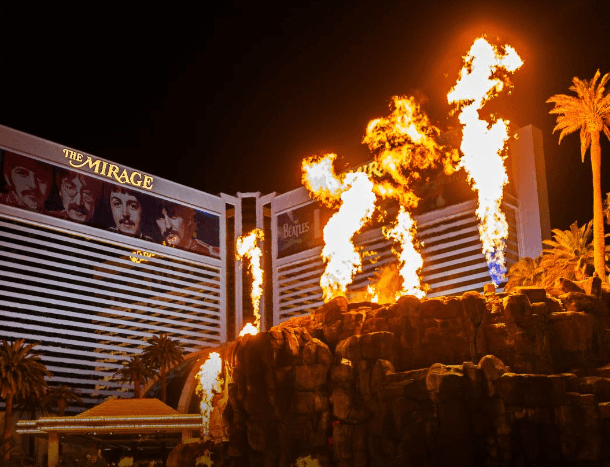
Life comes at you fast. It seems like only yesterday that I stood in a crowd of rubberneckers gawking at the artificial volcano that fronted the spanking new Mirage Hotel and Casino. After sundown, it erupted every 15 minutes, sending fireballs into the sky accompanied by a soundtrack of actual eruptions as the air was perfumed with the scent of a pina colada. In those days, late November of 1989 and beyond, the artificial volcano was Southern Nevada’s #1 tourist attraction, supplanting Hoover Dam.
I didn’t come to the 3,044-room Polynesian-themed resort to see the volcano. I came there to see the centerpiece of the grand opening festivities, a prizefight between Sugar Ray Leonard and Roberto Duran, the third meeting between the two gladiators. The Mirage had actually opened for business two weeks earlier, but it was a soft opening, as they say in the trade. The boxing event on Thursday, Dec. 7, 1989, was the cherry on the cake, a spectacle in every sense of the word. Celebrities were chaperoned to their ringside seats on a red carpet, mirroring the Oscars, and a mesmerizing fireworks display, better than New Years Eve, lit up the sky in the interlude between the last preliminary bout and the main event.
Leonard-Duran III was the first of 13 boxing shows at the Mirage, the last of which was staged in 1995. Thirteen isn’t many, but they included some of the biggest fights of the era, five of which – the first five – were staged under the stars in makeshift arenas built specifically for boxing. And now, with the closure of the Mirage today (July 17), another place that housed historic prizefights has dissipated into the dustbin of history.
The accoutrements were better than the fight. Roberto Duran had turned back the clock in his most recent bout, unseating middleweight title-holder Iran Barkley at the Atlantic City Convention Center, but against Sugar Ray he looked older than his 38 years. Leonard was content to out-box Duran and won nearly every round. The final chapter of the Four Kings round-robin (Leonard, Duran, Marvin Hagler, and Tommy Hearns) was a dud.
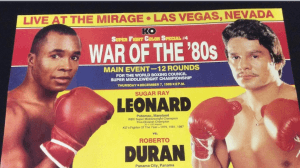
Two months after the Leonard-Duran rubber match, fringe contender James “Buster” Douglas shocked the world with a 10th-round stoppage of Mike Tyson.
Tyson-Douglas was in faraway Tokyo, but the Mirage became a sidebar to the story of the fight when mischievous Jimmy Vaccaro, who ran the Mirage Race and Sports Book, just for the fun of it posted odds on the match. That gave the Mirage a monopoly as it would be the only property in the bookmaking universe to take bets on the outcome of the fight.
The betting line bounced around a little bit and at one point the odds favoring Mike Tyson stood at 42/1. This price would come to be etched in stone. “42 to 1” became the title of an ESPN “30 for 30” documentary.
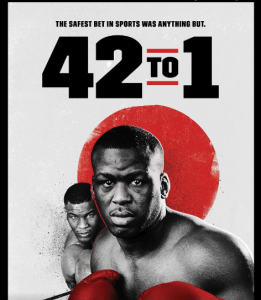
It wasn’t lost on Mirage founder and chairman Steve Wynn that Buster Douglas would be the perfect poster boy for a gambling establishment. After all, Buster was the Joe Blow that knocked out Superman and won the big jackpot. Wynn’s attorneys succeeded in extricating Douglas from the clutches of Don King and he was matched against Evander Holyfield, a former cruiserweight champion who was 24-0 with the last six wins coming as a heavyweight.
Worldwide, Douglas vs. Holyfield was a much bigger attraction than Leonard-Duran III. The Mirage reportedly credentialed 1,200 members of the media, many from overseas.
In the days leading up to the fight, there were rumors that Buster Douglas had been lax in his training. Those rumors were confirmed when Douglas weighed-in at 246 pounds, 14 ½ pounds more than he had carried for Mike Tyson.
Counting the intermissions between rounds, the fight lasted a shade over nine minutes. In the third frame, Buster missed with an uppercut and Holyfield countered with an overhand right that landed on the temple. Buster fell to the canvas and made no attempt to rise as referee Mills Lane tolled the 10-count. As he lay there, picking at his nose, the scene was reminiscent of the famous photo of Jack Johnson lying on his back with his right arm shading his eyes from the sun at the conclusion of his 1915 fight with Jess Willard, a match that would always beg the question of whether Johnson was faking it.
Steve Wynn, who could be charming but was a perfectionist with a volatile temper, was livid. On the streets of Las Vegas, there was talk that Wynn had Douglas and his crew evicted from their hotel rooms even before the arena was locked down. If it were true that Buster Douglas was given the bum’s rush like some deadbeat inhabitant of a fleabag hotel, he would have been the first millionaire to experience this indignity. His purse was reportedly $24 million with $19.9 million guaranteed (roughly $40 million in today’s dollars).
Wynn partnered with promoter Bob Arum for the Leonard-Duran fight. For Douglas-Holyfield, he decided to go it alone, eliminating the middleman. By his reckoning, he had people on staff who were quite capable of getting all the moving parts to mesh into a coherent whole. But manufacturing a megafight is a complicated undertaking and Wynn would discover that he had over-reached. Plus, he had soured on boxing after two stinkers.
History would show that Steve Wynn would never again commit a large amount of money to host a prizefight. But this didn’t mark the end of boxing at the Mirage as Wynn owed Don King some dates as part of the out-of-court settlement that freed Buster Douglas from King’s grasp and a handful of promoters with lesser clout (e.g., Kathy Duva, Cedric Kushner, Dan Goossen) would anchor an occasional show there in a four-wall arrangement.
Don King’s first two Mirage promotions pit Mike Tyson against Razor Ruddock. Tyson stopped Ruddock in the seventh round on March 18, 1991. The stoppage by referee Richard Steele, which struck many as premature, sparked a wild melee in the ring between the opposing handlers. The sequel in June went the distance. Tyson copped the decision. Take away the three points that Ruddock was docked for low blows and Tyson still would have won.
King also promoted the last of the outdoor shows at the Mirage, a September 14, 1991 card topped by Julio Cesar Chavez’s super lightweight title defense against Lonnie Smith. In hindsight, this event was historically important.
Although Chavez was a massive favorite and the weather was oppressively hot, the Mexican Independence Day weekend fight attracted a larger-than-expected turnout of mostly Mexican tourists with deep pockets. In future years, many big fights in Las Vegas would be noosed to a Mexican holiday weekend. Chavez vs Smith was the ice-breaker.
In addition to Leonard, Duran, Holyfield, Tyson, and Chavez, future Hall of Famers Riddick Bowe, Jeff Fenech, Azumah Nelson, Buddy McGirt, and Michael Carbajal appeared at the Mirage. “Big Daddy” Bowe never headlined a show at the Mirage but had three fights here preceding his memorable trilogy with Evander Holyfield.
—
Steve Wynn divested his interest in the Mirage in 2000 and the property became part of the MGM consortium. In December of 2021, the property was purchased by the Hard Rock organization whose parent company, as it were, is the Seminole Indian tribe of Florida. The transition from the Mirage to the Hard Rock is expected to take almost three years. When the renovation is finished, the property will have a new hotel tower shaped like a giant guitar. The guitar, the symbol of the Hard Rock brand, couldn’t hold the volcano’s jockstrap, but it is what it is in the city that constantly reinvents itself.
Back when the Mirage opened, the charismatic Steve Wynn was the most admired man in town. An innovator and a true visionary, Wynn melded the sensibilities of Walt Disney and Bugsy Siegel and changed the face of the Las Vegas Strip. Wynn still has a large footprint in Las Vegas reflected in two look-alike five star hotel-casinos, the Wynn and the Encore, but, incredibly, he is now persona non grata in the city that once worshiped him. His fall from grace is not a proper subject for this website. Suffice it to say that Wynn, now 82, was quite the philanderer in his younger days and his recklessness caught up with him.
Yes, a lot of water has passed under the bridge since that memorable night almost 35 years ago when Sugar Ray Leonard and Roberto Duran formally christened the newest and brightest jewel on the Las Vegas landscape. Those were the days, my friend, and for some of us it seems like only yesterday.
—
A recognized authority on the history of prizefighting and the history of American sports gambling, TSS editor-in-chief Arne K. Lang is the author of five books including “Prizefighting: An American History,” released by McFarland in 2008 and re-released in a paperback edition in 2020.
To comment on this story in the Forum CLICK HERE
-

 Featured Articles4 weeks ago
Featured Articles4 weeks agoAvila Perspective, Chap. 330: Matchroom in New York plus the Latest on Canelo-Crawford
-

 Featured Articles3 weeks ago
Featured Articles3 weeks agoVito Mielnicki Jr Whitewashes Kamil Gardzielik Before the Home Folks in Newark
-

 Featured Articles19 hours ago
Featured Articles19 hours agoResults and Recaps from New York Where Taylor Edged Serrano Once Again
-

 Featured Articles4 weeks ago
Featured Articles4 weeks agoCatching Up with Clay Moyle Who Talks About His Massive Collection of Boxing Books
-

 Featured Articles5 days ago
Featured Articles5 days agoFrom a Sympathetic Figure to a Pariah: The Travails of Julio Cesar Chavez Jr
-

 Featured Articles3 weeks ago
Featured Articles3 weeks agoMore Medals for Hawaii’s Patricio Family at the USA Boxing Summer Festival
-

 Featured Articles1 week ago
Featured Articles1 week agoCatterall vs Eubank Ends Prematurely; Catterall Wins a Technical Decision
-

 Featured Articles4 weeks ago
Featured Articles4 weeks agoRichardson Hitchins Batters and Stops George Kambosos at Madison Square Garden



